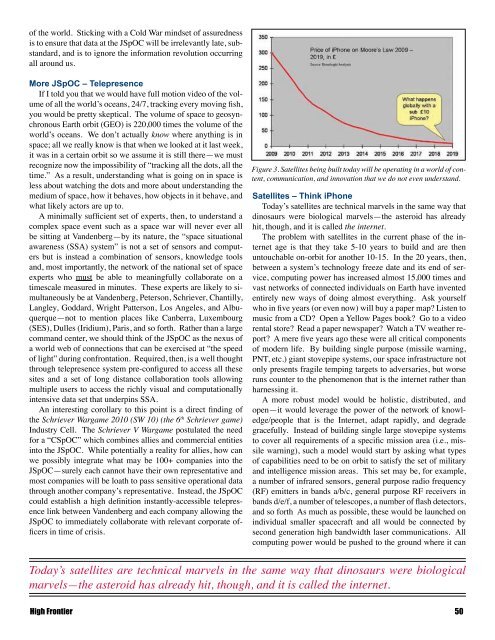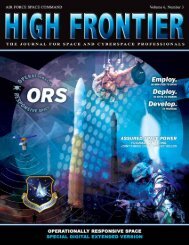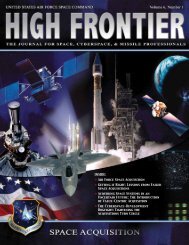Schriever Wargame 2010 - Air Force Space Command
Schriever Wargame 2010 - Air Force Space Command
Schriever Wargame 2010 - Air Force Space Command
- No tags were found...
Create successful ePaper yourself
Turn your PDF publications into a flip-book with our unique Google optimized e-Paper software.
of the world. Sticking with a Cold War mindset of assuredness<br />
is to ensure that data at the JSpOC will be irrelevantly late, substandard,<br />
and is to ignore the information revolution occurring<br />
all around us.<br />
More JSpOC – Telepresence<br />
If I told you that we would have full motion video of the volume<br />
of all the world’s oceans, 24/7, tracking every moving fish,<br />
you would be pretty skeptical. The volume of space to geosynchronous<br />
Earth orbit (GEO) is 220,000 times the volume of the<br />
world’s oceans. We don’t actually know where anything is in<br />
space; all we really know is that when we looked at it last week,<br />
it was in a certain orbit so we assume it is still there—we must<br />
recognize now the impossibility of “tracking all the dots, all the<br />
time.” As a result, understanding what is going on in space is<br />
less about watching the dots and more about understanding the<br />
medium of space, how it behaves, how objects in it behave, and<br />
what likely actors are up to.<br />
A minimally sufficient set of experts, then, to understand a<br />
complex space event such as a space war will never ever all<br />
be sitting at Vandenberg—by its nature, the “space situational<br />
awareness (SSA) system” is not a set of sensors and computers<br />
but is instead a combination of sensors, knowledge tools<br />
and, most importantly, the network of the national set of space<br />
experts who must be able to meaningfully collaborate on a<br />
timescale measured in minutes. These experts are likely to simultaneously<br />
be at Vandenberg, Peterson, <strong>Schriever</strong>, Chantilly,<br />
Langley, Goddard, Wright Patterson, Los Angeles, and Albuquerque—not<br />
to mention places like Canberra, Luxembourg<br />
(SES), Dulles (Iridium), Paris, and so forth. Rather than a large<br />
command center, we should think of the JSpOC as the nexus of<br />
a world web of connections that can be exercised at “the speed<br />
of light” during confrontation. Required, then, is a well thought<br />
through telepresence system pre-configured to access all these<br />
sites and a set of long distance collaboration tools allowing<br />
multiple users to access the richly visual and computationally<br />
intensive data set that underpins SSA.<br />
An interesting corollary to this point is a direct finding of<br />
the <strong>Schriever</strong> <strong>Wargame</strong> <strong>2010</strong> (SW 10) (the 6 th <strong>Schriever</strong> game)<br />
Industry Cell. The <strong>Schriever</strong> V <strong>Wargame</strong> postulated the need<br />
for a “CSpOC” which combines allies and commercial entities<br />
into the JSpOC. While potentially a reality for allies, how can<br />
we possibly integrate what may be 100+ companies into the<br />
JSpOC—surely each cannot have their own representative and<br />
most companies will be loath to pass sensitive operational data<br />
through another company’s representative. Instead, the JSpOC<br />
could establish a high definition instantly-accessible telepresence<br />
link between Vandenberg and each company allowing the<br />
JSpOC to immediately collaborate with relevant corporate officers<br />
in time of crisis.<br />
Figure 3. Satellites being built today will be operating in a world of content,<br />
communication, and innovation that we do not even understand.<br />
Satellites – Think iPhone<br />
Today’s satellites are technical marvels in the same way that<br />
dinosaurs were biological marvels—the asteroid has already<br />
hit, though, and it is called the internet.<br />
The problem with satellites in the current phase of the internet<br />
age is that they take 5-10 years to build and are then<br />
untouchable on-orbit for another 10-15. In the 20 years, then,<br />
between a system’s technology freeze date and its end of service,<br />
computing power has increased almost 15,000 times and<br />
vast networks of connected individuals on Earth have invented<br />
entirely new ways of doing almost everything. Ask yourself<br />
who in five years (or even now) will buy a paper map Listen to<br />
music from a CD Open a Yellow Pages book Go to a video<br />
rental store Read a paper newspaper Watch a TV weather report<br />
A mere five years ago these were all critical components<br />
of modern life. By building single purpose (missile warning,<br />
PNT, etc.) giant stovepipe systems, our space infrastructure not<br />
only presents fragile temping targets to adversaries, but worse<br />
runs counter to the phenomenon that is the internet rather than<br />
harnessing it.<br />
A more robust model would be holistic, distributed, and<br />
open—it would leverage the power of the network of knowledge/people<br />
that is the Internet, adapt rapidly, and degrade<br />
gracefully. Instead of building single large stovepipe systems<br />
to cover all requirements of a specific mission area (i.e., missile<br />
warning), such a model would start by asking what types<br />
of capabilities need to be on orbit to satisfy the set of military<br />
and intelligence mission areas. This set may be, for example,<br />
a number of infrared sensors, general purpose radio frequency<br />
(RF) emitters in bands a/b/c, general purpose RF receivers in<br />
bands d/e/f, a number of telescopes, a number of flash detectors,<br />
and so forth As much as possible, these would be launched on<br />
individual smaller spacecraft and all would be connected by<br />
second generation high bandwidth laser communications. All<br />
computing power would be pushed to the ground where it can<br />
Today’s satellites are technical marvels in the same way that dinosaurs were biological<br />
marvels—the asteroid has already hit, though, and it is called the internet.<br />
High Frontier 50











